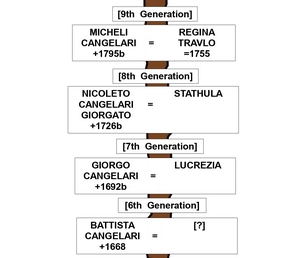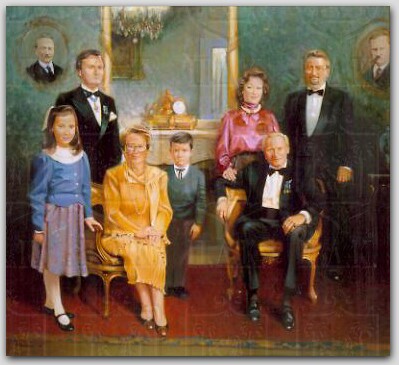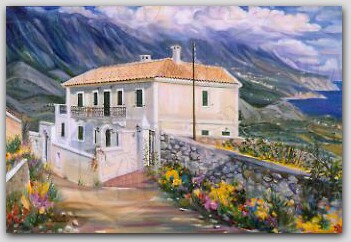|
The ancient Cangelari Family (Cangellari, Canghelari or Kangelari) derive their origin from Byzantium where their surname is mentioned since the beginning of 12th century in the person of the famous hagiographer Lucas Cancellari, creator, among others, of the marvellous icon of Madonna Nicopeia or Nikopeia (Panagia Nikopoia), which up to this day adorns Saint Mark's Basilica in Venice. Their Byzantine origin is confirmed by the etymology of their surname, which comes from the Latin word cancellarius, that virtually means chief secretary. At the time of the Byzantine Empire, the cancellarii were higher ranking civil servants (patricians) belonging to the judiciary of the Byzantine state. After the Fall of Constantinople (1453) to the invading forces of the Ottoman Sultan Mehmet II (1432-1481), the Cangelaris took initially refuge on the island of Corfu, to finally settle permanently, at the beginning of 16th century, on the island of Cephalonia, just after its conquest by the Venetians. There, they were granted the highland village of Vari, with the objective of militarily defending this northern and, at that time, most rough and inaccessible part of the island, the region of Erisso, whose defence they undertook until the erection of the Fortress of Asso (1593). The Family will develop their social and economic activity at Vari and the larger area of Erisso at least for the following three centuries, whereas some of their branches, with another now surname, are still living there to this day. At the same time, in line with the relevant for the noble families of the island governmental regulations, they possessed (at least since 1568) a house in the capital, the Fortress of Saint George, where their members will live (inside the fortress or at its suburb) during the whole period of the Venetian rule and even beyond that, up to this day. Later on, members of the Family will immigrate to other areas of the island, such as Pirgo (the small fortress that was the seat of the Family's military corps and later gave its name to today's village of that name), Vassilicades, the Fortress and the Strait of Asso, the village of Cotrea and other neighbouring ones as well, where however the direct male lines came to an end. The first serious migratory movement of the Family took place by the middle of 17th and particularly the beginning of 18th centuries, when branches settled at Sami and the neighbouring villages of Alevrata, Grisata and Servata, at Lixuri and Manzavinata, and at Argostoli. It is then that the first migration out of the island took place too, this time towards the neighbouring island of Santa Maura. This migration will be finalised by the time of the island's definite liberation from the Ottoman yoke, when members of the Family will establish themselves at the City of Santa Maura and Amaxichi (today's City of Leucas), or especially at the village of Saint Peter (Aghios Petros), at the southern part of the island, where their descendants are living up to this day. The population increase that is noticed in the middle of 17th century shows, for the first time in a massive way, the phenomenon of evolution and change of family surnames in Cephalonia. This is particularly marked within large families and aims to better distinction between different branches of the same family. The new surnames derive either from nicknames or (in most cases) from the Christian first name of a usually prominent member of that family, whose children or grand-children wish to distinguish themselves from their homonymous relatives. Thus, a number of branches are then created within the Cangelari Family many of who will keep their new family surname while other will reject them. In their case this process first appears by the middle of 17th century to be concluded, one way or the other, by the middle of 18th century. Several of these branches with their new surnames exist until today both in Cephalonia and elsewhere and it is worth noticing that at the cradle of the Family, the village Vari of Erisso, no family with the name Cangelari lives permanently today, while on the contrary many of their branches that had then opted for new surnames do so. In the Cangelari Family case this phenomenon obviously appears for the first time at Vari. From the branches that have then been created those of the Seppato, Danato, Teodossato, Galiazzato, Giacomato, Liossato and Papadimitrato exist there to this day together with other branches that arose from their hearts, such as the Vangelato, Velissarato, Prassa and Staffieri from the Seppato, the Matiato from the Danato or the Diacato and Pavlato from the Galiazzato. One more large branch, that of Battistato, was soon split into other equally numerous branches (those of the Giorgato, Zuganato, Stamatato, Zamani, Tacugni and Lurando) of whom the majority still exists at Vari, while that of the Lurando (which by the middle of 18th century established themselves at the Suburb of Saint George) early rejected the new surname and exists until now with their initial surname of Cangelari. More branches will appear at Vari during that period, but either will reject soon their new surnames or come later to extinction, such as the Alissandrato, Valianato, Giannato, Todorato, Marcato, Papastathato, Zefferi and Psaro. Following the establishment of the Family at Lixuri new branches were created there, namely those of the Paluchi and Sara, while the new surname of Rissiano emerged in two branches of the Family, one in Manzavinata and the other in Argostoli. Almost at their totality, however, these last branches came back to their initial family surname of Cangelari. At the outset a Family of skilful warriors and priests, the Cangelaris will soon associate their latter-day renown with the defence of the island. In the service of the Serenissima since 1550 they will encounter with success enemy and pirate incursions and, parallel to their mission of spying on the eventual movements and military preparations of the Ottoman forces in opposite Mainland Greece, they will be entrusted with the military command of the region of Erisso. As a result of their military activities many members of the Family will not avoid the misfortunes of slavery due either to pirate incursions or military confrontations. Especially during the War of Crete (1645-1669) these cases will increase. The Cangelaris will distinguish themselves in the diplomatic field too by participating in a large embassy of the Community of Cephalonia that travelled to Venice in 1561 to achieve the free trading of cereals in the island. Especially during the first centuries agriculture was the basic occupation of the inhabitants of Cephalonia. Naturally, the Cangelari Family too was engaged in the exploitation of their domains (which at that time were producing cereals, raisins, olives, wine, etc.), while simultaneously were occupied with livestock breeding and to a lesser extent shipping. Although no records of proceedings of the Council of the Community of Cephalonia before 1593 have been saved through the ages, the participation of the Cangelari Family to its meetings may be considered as certain since their members have been elected ambassadors in 1561. Since 1652 however the Family participates to its deliberations without interruption for four consecutive generations. Another most important office of the civil life of Cephalonia, on which many members of the Cangelari Family were appointed, was also that of the public notaries. The records of only four of them are extant up to this day but between them is the third oldest known in the island, that of Frango Cangelari. The Cangelari Family will produce a line of head priests, priests, deacons, monks and other clergymen, as well as elders, teachers, physicians, constables, etc. during the whole period of the Venetian rule. Especially the number of priests was considerably big at that time by which the Family shows full generations of clergymen. In later days, at the end of 19th and the beginning of 20th centuries, another monk in the Family will be one of the early socialist activists of the then Kingdom of Greece. Moreover, the care of the Family chapels and fraternity churches was at the responsibility of the church wardens (gastaldi), usually coming from the same family. In Vari, already since the 16th century, we find wardens of the two biggest Family churches, the famous (crossed with vaulted dome and characteristic frescoes depicting the punishment of the trespasser) Our Lady of Cugiana and that of Saint Stephen. Finally, since the middle of 19th century branches of the Family establish themselves permanently in Athens, Patras, Andravida and other parts of Greece, in Constantinople (now Istanbul), the opposite located Kios (now Gemlik) and the Princess Islands (now Kizil Adalar) of the then Ottoman Empire, in Braila of Romania, in Kerch of Crimea, as well as in Suez and Alexandria of Egypt. In 20th century members of the Family searched for a better chance in Africa (Asmara of Erithrea, Belgian Congo, Burundi a.o.), Jerusalem and Cyprus as well as the United States of America and Australia. There their members will prosper in the fields of trade, shipping, transports, letters, arts and sciences. As expected, during these last 500 years since their arrival in Cephalonia, they have repeatedly changed their citizenship status as a result of the political and strategic changes in the region. The Cephalonian and Alexandrine Greek from Egypt Panayotis D. Cangelaris belongs to the 16th generation since the establishment of the Family in this Ionian Island. He is the son of Demetre P. Canghelaris (1922-1996) and Angélique J. Kyriacou (1925-1987). His father was born in Suez Egypt, took part in the Second World War as a flying fighter with the 13th Light Bomber Squadron of the Royal Hellenic Air Force (R.H.A.F.) and saw action in the fronts of the Middle East, Southern Italy and the Aegean, to become later a successful custom broker, international forwarder and shipping and travel agent. They both are direct descendants of head priest (protopapa) Georgi Cangelari (died before 1565) and his grandson captain Marco Cangelari, ambassador of the Community of Cephalonia to Venice in 1561. The latter, together with his uncle, captain Danea Cangelari, military commander of the region of Erisso since 1563, distinguished themselves both in the military and diplomatic fields. His son Alexis was captured slave for a short time before 1596, like the great grandson of the latter, Giorgo Cangelari (founder of the Giorgato branch), who, fighting at the War of Crete, was taken prisoner during the siege of Candia (1669) and remained slave until at least 1672. The latter's grandson Micheli Cangelari, founder of the Lurando branch, settled in 1755 at the Suburb of Saint George (today's village of Kastro), where his son Panagin (died before 1808) started a four generations tradition of tailors in the Family. The latter's great grandson Demetrio P. Cangelari (1844-1898) will be the last ancestor of Panayotis D. Cangelaris to be born there. At the end of 19th century his grandfather Panagis D. Canghelaris (1873-1936), who was born in Argostoli, will settle in Egypt, where he will be engaged in trade and international forwarding. It is there that he will invite the rest of his family and take care of his younger and then still under age half-brothers and sister, the francophone poet Gérasime (1890-1925), the prominent barrister Élie (1891-1934) and the Alexandrine intellectual Kate (1896-1958) Cangellaris, renowned for her literary salon there. Related page: |









